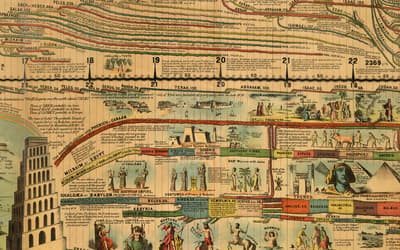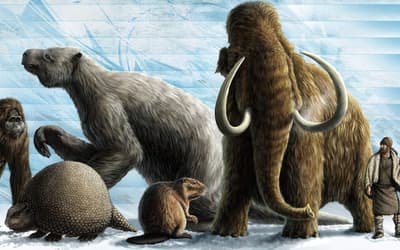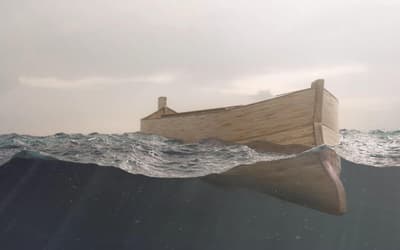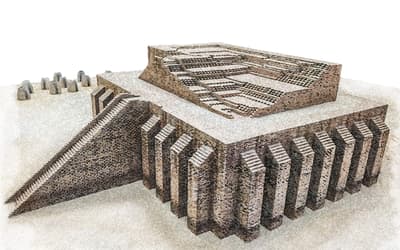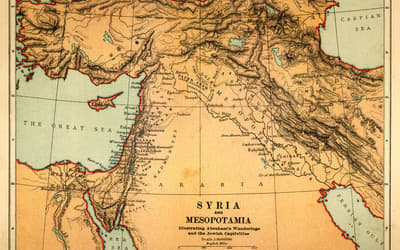The views expressed in this paper are those of the writer(s) and are not necessarily those of the ARJ Editor or Answers in Genesis.
Abstract
It will be shown that, although Griffith and White claim to support the Ussher (Masoretic) chronology of the world in this set of papers, their many pagan sources actually reinforce the longer Septuagint timeline. The crux of this issue is that they totally ignore the Ice Age, and do not mention its meltdown, which caused enormous flooding in many countries around the world. This post-Ice Age flooding is confused with Noah’s earlier global flood by Griffith and White, who mistakenly assume that whenever “flood” is mentioned by ancient historians, it is Noah’s flood that is meant. The authors also erroneously treat mention of the cities of Babel and Babylon interchangeably, not recognizing that they are different cities founded in a different time and place. Babel was built in North Mesopotamia before the Ice Age meltdown, and Babylon was built hundreds of years later in South Mesopotamia on top of the post-Ice Age flooding sediments that formed the delta of South Iraq. In addition, claims that pagan nations point to the Usshur creation date of 4004 B.C. are shown to be false.
Keywords: Usshur Chronology, Masoretic, Septuagint, Ice Age, Ice Age meltdown, Noah’s Flood, geology, North Mesopotamia, South Mesopotamia, Egypt, Babel, Babylon, Creation
Introduction
This paper consists of comments on the series of papers by Griffith and White (2022a, 2022b, 2023a, 2023b, 2023c). We will start by pointing out why the Ice Age, which they essentially ignore, is central to the problem with their entire chronological argument and why the meltdown of the ice is the Achilles heel of this entire series.
Statement of the Problem
The issue with the Griffith and White 2022a chronology stares us right in the face in their initial Abstract (Griffith and White 2022a, 377). They tell us that they are going to make the 12,000-year secular (conventional) history of the Ancient Near East (ANE) fit into Usshur’s chronology of the Bible (that is, the Masoretic version). Usshur’s date for the biblical Flood is 2348 B.C. (Usshur 2007, 21). Griffith and White plan to show that the histories of the ANE countries back this date up.
Why is this a problem? It is because that 12,000-year history of the ANE is a figure that should look familiar to anyone who knows the secular timeline. Twelve thousand years ago is about the time of the meltdown at the end of the Ice Age, when there was great flooding in many parts of the world (Habermehl 2013). But that flooding was not Noah’s Flood. The latter was a separate event that took place long before the Ice Age meltdown. This means that there were two major floods in the history of the world, the global flood of Noah and the flooding at the end of the Ice Age. The biggest one was Noah’s flood, of course. But to the peoples who started their nations’ histories only after the Ice Age, the flooding from the latter seemed catastrophic enough in its effects.
The issue here is that the Ice Age and its flooding is not mentioned in the Griffith and White chronology at all as distinct from Noah’s Flood. This is a major error in their logic that essentially negates the thesis of their entire series (20 papers in all, 15 more to come). Their thesis is that they are supporting the MT timeline. But they are doing this by confusing the two separate floods, and treating them as if they are one.
It is only after the flooding caused by the Ice Age that all these ancient writers quoted by Griffith and White count their origins and start their history. We will look at the timeline implications of this shortly.
The Ice Age and Its Meltdown
First, we need to look further at the Ice Age and its aftereffects.
Long ago in earth’s history, sometime after Noah’s flood, there was a great, catastrophic ice age, when ice formed by water from the oceans built up on the continents so immensely that global ocean waters lowered 400 ft below current levels (Smithsonian n.d.). Then, sometime after the Babel dispersion, there occurred what we might call the granddaddy of all climate changes, when that ice rather suddenly started to melt. The rapid melting of the ice caused major flooding around the world as the meltwaters roared down to the sea, causing havoc. In Mesopotamia the meltwaters from Turkey to the north and the Zagros mountains to the east washed vast amounts of sediments into the great delta that is now south Iraq (Habermehl 2013). This delta area had been under water after Noah’s flood until the ice buildup. The weather patterns of the globe were disturbed during that time, and the shift in rainbelts over Africa caused the Nile River to go crazy, washing so much sediment northward to the Mediterranean that it formed the Egyptian Nile Delta in its entirety (Habermehl 2013). It was only after the enormous flooding from the melting of the ice that mankind began to build the nations that we know. The post-Ice Age flooding was a great, important event in the world’s history.
Exactly when the ice started to build up after Noah’s Flood is not certain, as there is no biblical marker for this. We do know that the meltdown flooding and its aftereffects had to have ended well before Abraham (Habermehl 2013).
This catastrophic meltdown event was retained in the collective memories of the peoples affected, who called it the flood.
In Griffith and White (2023b), they remark on how closely the various chroniclers agree with each other. This is not surprising, as these ancient historians no doubt kept good records. But then Griffith and White say that these chroniclers all agree with the Usshur chronology. This is where I must disagree. The ancient historians all agree on the time of their previous great flood, which was after the Ice Age, not after Noah’s Flood. Table 2 in Griffith and White (2023b) shows 16 dates from ancient sources, all in the range of about 2316–2383 B.C. It is merely by coincidence that this range falls in the same century as the Usshur date of Noah’s Flood of 2348.
Table 1 shows how these events work out on the LXX and MT. As Table 1 shows, melting of the ice occurred on the LXX and MT some time before Abraham. On the LXX timeline, Noah’s Flood, the dispersion, and the Ice Age flooding are spread apart by many centuries. But because there is so little time in the MT, Noah’s Flood and the Ice Age flooding are crowded together very closely, with the Babel dispersion occurring between the two.
Table 1. Historical events on the LXX and MT timelines.
| Event | LXX | MT |
|---|---|---|
| Creation | 5500 B.C. | 4000 B.C. |
| Noah’s Flood | 3300 B.C. | 2350 B.C. |
| Babel Dispersion | 2770 B.C. | 2250 B.C. |
| End Ice Age Flooding | Before Abraham (before 2000 B.C.) | Before Abraham (before 2000 B.C.) |
| Founding of Babylon | After Ice Age flooding | After Ice Age flooding |
On the MT timeline, there really isn’t time for the Ice Age, let alone any other historical events that took place between the Flood and Abraham. Even if the Ice Age is greatly shortened, so that its buildup and meltdown occur very rapidly, there are additional geological and historical events that have to take place during that narrow MT slot as well.
On the longer LXX timeline, the Ice Age meltdown could have taken place at close to the same time as the Usshur Flood date of about 2350. (It isn’t possible to set an exact biblical date for the meltdown.)
Although the Ice Age is mentioned often in the creationist literature, it is not always made clear just how catastrophic an event it was. Nonetheless, it is surprising to find a series of historical papers like this that makes their arguments as if there was no Ice Age at all.
Griffith and White have inadvertently backed the LXX in so doing. The Ice Age, which they have glaringly omitted from their entire thesis, guts their argument that they have supported the MT.
Why the Nations Cannot Have Been Founded Immediately After Noah’s Flood
As we know from the Bible, events following the Flood started with Noah and his family leaving the Ark and eventually making their way to the Plain of Shinar. There they built four cities, including Babel. From there they were dispersed in all directions around the world. In the places where they settled, they eventually became nations. All this had to have required time—quite a bit of it.
Scientists know that there was a great catastrophic time of ice buildup and meltdown that had to be tucked somewhere into this time between the Ark and the founding of the nations.
But in the Griffith and White scenario, these nations claim that their history started immediately after a flood. There is no indication that a great deal of time has gone by since this flood until the founding of their nations.
What is important here is that mention of a flood does not necessarily mean Noah’s Flood. These nations do not mention anything like a global flood in their history. The logical conclusion is that it was the Ice Age-caused flood they refer to as the beginning point of their national history. (See Habermehl 2013 for more on this.)
The LXX, the MT and the Two Floods
We note here that the reason that the LXX has more time is because of the longer begetting time between generations of humans in the Genesis genealogy chapters. It does not, as Griffith and White incorrectly (and oddly) state, give its supporters “space to accept the evolutionist’s chronologies for the dynastic periods in Egypt and Mesopotamia.” Clearly Griffith and White have no concept of the LXX at all. On the Egyptian (secular) timeline, Abraham visits Egypt around 3000 B.C., at the beginning of the dynasties, as is shown by synchronization of the Egyptian and biblical timelines (see Habermehl 2023). But on both the LXX and MT, Abraham’s visit to Egypt is around 1900 B.C. The difference between the LXX and MT only shows up earlier in the time of Abraham’s grandfather, Nahor (Genesis 11:24). This has nothing to do with the Egyptian dynasties, that came somewhat later.
Conflation of Babel and Babylon
In Griffith and White 2022b, they incorrectly treat Babel and Babylon as the same city, and this is a major error. As noted earlier, Babel was the city built in Shinar in the north by the rebellious descendants of Noah, before the dispersion (Genesis 11). Babylon was built much later, in Southern Mesopotamia, after the flooding of the Ice Age meltdown, on top of the sediments that formed south Iraq. For an extensive treatment of this subject, including linguistic reasons why Babel and Babylon are not the same name, see Habermehl (2011).
The date of the Babel dispersion on the LXX is considered to be about the time of Peleg, 530 years after Noah’s flood. This is well before the Ice Age meltdown, as we know that the maximum of the ice buildup was some time after the Babel dispersion; the Neanderthals tell us this (Habermehl 2010).
Griffith and White put the founding of their Babel/Babylon city at about 2200+ B.C., using three sources. The Babel dispersion was about 100 years after Noah’s Flood on the MT timeline. It is this MT date that Griffith and White believe the pagan historians are referring to. This is why the dates of founding Babel/Babylon are confused, as well as the names of the two cities.
Because it is Babylon that was built after the formation of the delta of south Iraq, it is the city that the ancient writers refer to when they speak of the beginning of their history.
Also, the authors’ claim that Babel was founded 42 years before the dispersion, based on their pagan sources, must refer to the founding of Babylon after the Ice Age. There is no biblical marker for the founding of Babel, other than that it must have been soon after Nimrod’s birth (Nimrod’s name means “Let us rebel”) (Hendel 2001, 218). This name would have been given him at birth.
Pagan Dating of the Ice Age Flood
Their statement in Griffith and White 2023b that the first cities in Egypt were founded only three years after the Babel dispersion is not remotely credible. Too many events, including the Ice Age and its flooding, had to have taken place before the cities were founded.
The Griffith and White claim that Nimrod must be Ninus gets us into such a mishmash of pseudohistory that I will not pursue trying to sort it out, if that is even possible. I will only state here that Nimrod was a real person who lived at Babel before the Dispersion, and did indeed found the original city of Nineveh (Genesis 10:8–11). But that was long before the Ice Age flooding, and therefore long before Ninus (if he actually existed). As with all these other nations, the known history of Nineveh only starts after the Ice Age, with a date of about 6000 B.C. secular (Nineveh 2024). However, the original Nineveh of Nimrod would have been founded long before, not long after the Dispersion.
Göbekli Tepe dates to about 12,000 years ago, the end of the Ice Age. It therefore dates to the earliest humanity after the Ice Age flooding, not immediately after Noah’s Flood. Whether or not it was an observatory is a matter of discussion among scholars. See my paper on Göbekli Tepe for an extensive treatment of Göbekli Tepe (Habermehl 2018).
The great semi-mythical Chinese flood is clearly a remembrance from the flooding of the Ice Age meltdown (Great Flood [China] 2024). The Chinese description of it bears no resemblance to Noah’s flood. I am incredulous that Griffith and White suggest that the Chinese tribes began organizing before the Dispersion. This is special pleading of the highest order and is due to conflating Babel with Babylon in their chronology.
The remainder of the examples given by Griffith and White are all due to conflating Noah’s Flood with the post-Ice-Age flooding.
Pagan Dating of Creation
Because the ancient pagan historians only go back to the Ice Age flooding in their records, we might wonder whether they actually have any idea when the universe was created. It would appear that they do not, as their histories appear to depend on myths for this.
We will look at a couple of examples of pagan dates for Creation given by Griffith and White (2023b). Their fig. 2 shows these peoples dating Creation to 4004 B.C. As I will show here, this does not hold up.
India: According to Hindus, the universe is 155 trillion years old (Goyal 2008). Obviously the Hindu creation did not take place in 4004 B.C. as claimed by Hamilton (1820). I consider this Hamilton, whoever he was, to be a very unreliable reference. Did he make it all up? Unfortunately, he is dead and cannot enlighten us on this. However, it would have been a good idea for Griffith and White to have double checked this fact via Google.
Chinese creation beliefs: There are quite a few variations on this, depending on various Chinese cultures. Readers are invited to read this online page listing at least nine different myths, including that the Chinese have no creation myth (see Chinese Creation Myths (2023)). Hamilton (1820) is again the source for Griffith and White on claiming that the Chinese support Usshur. It appears that they most certainly do not.
A Few Notes on the Babylonian Dynasties (Griffith and White 2023c)
I have seen no reason anywhere to believe that Akkad was Babylon. Scholars admit that they do not know where it was (Mark 2011). However, I have made a strong case in my paper on Babel (Habermehl 2011) that Akkad was Tell Brak in Northern Mesopotamia.
I would take issue with Griffith and White saying that not all Semites spoke Semitic languages (that is a rather strange thing to say). It is true that the Elamites from Elam at the south of Iran were not Semites. But they were not the Elamites mentioned in the Bible; biblical Elam was a son of Shem (Genesis 10:22). He was a Semite who settled on the Euphrates River south of Carchemish (Grayson 2000, 254), the location of ancient Elam, called Elammu or Elamtu in the early literature. Most of the people who inhabit the Elam of Iran are not Semites (that Elam’s name is a linguistic coincidence). It was the king of the Elam near Carchemish in the north who would have been mentioned in Genesis 14:1.
Nimrod seems to be known by many names. However, biblical Nimrod himself lived long before any of the other characters that he is claimed to be. As an example, Nimrod was not Narmer, the first pharaoh of the first Dynasty. Nimrod lived long, long before this, at the time of the Babel dispersion. Narmer lived at the time of the first Egyptian dynasty, about the time of Abraham (Mark 2016). Enmerkar, who is not Nimrod, either, is a figure of dubious historicity in the Sumerian poetic literature (Mark 2023). If he existed, he lived far later than Narmer, in the Ur III period.
Setting the Record Straight
This is where I will address the very garbled version of my paper on Egypt and the Ice Age (Habermehl 2013) that is mentioned by Griffith and White (2023b, 487) :
Habermehl tries to set chronological limits on the duration from the Flood to the founding of Babel and Egypt based on geological arguments combined with the LXX chronology. She assumes that the Ice Age occurred immediately after the Flood, and that it had to have lasted five centuries (Habermehl 2013). She states that Egypt could not have been founded until after the Ice Age, because of the “Wild Nile” floods that she presumes occurred as the African glaciers melted at the end of the Ice Age. She makes a similar argument for lower Mesopotamia (Habermehl 2011, 31–33). Given that the earliest extra-biblical records of the activities of Noah (Legge 1899), Belus, and Menes involved flood control projects, and that Egyptian civilization revolved around the flooding of the Nile, we are unpersuaded that flooding of the Nile presents a chronological limitation for the founding of Egypt.
It would be a good idea for readers to read both of these papers (Habermehl 2011 and 2013) in their entirety. However, I will briefly state the following:
- Babel and Babylon are two different cities, built in different places, at very different times.
- The length of time (“duration”) from Noah’s Flood to Babel (not Babylon) is set by the Bible, whether MT or LXX, and there is nothing to discuss. Also, I do not discuss the time between the post-Ice Age flooding and the founding of Babylon (not Babel) in South Mesopotamia, nor the time between Noah’s Flood and the founding of Babylon (not Babel). It appears that Griffith and White have conflated Babel and Babylon here, something that I do not ever do.
- I do not assume that the Ice Age began to form immediately after the Flood. This assumption is made by Oard in his Ice Age Model, and he should have been referenced on this (see Oard 1990).
- I do not assume that the Ice Age lasted five centuries. The assumption of the length of the Ice Age plus meltdown is a total of 500 + 200 = 700 years, made by Oard in his Ice Age Model. He should have been referenced on this (see Oard 1990). I do discuss various possibilities with respect to the causes of the Ice Age. Because I do not see a marker for the beginning of the Ice Age, I do not take a position on how long it lasted, only on when it ended.
- I do not “presume” that Egypt was founded after the Ice Age. I know that this is what really happened, based on scientific facts, especially geology.
- The “wild Nile” was largely caused by the shifting of the rain belts northwards in Africa, as I clearly explain in that paper (Habermehl 2013). Melting African glaciers would have been a lesser contribution.
- It was the post-Ice-Age “wild Nile” flooding that produced the entire Egyptian Delta over a very short time. The known history of Egypt starts after that Delta was in place. The normal annual flooding of the Nile in later historical times had nothing to do with what happened when the Delta was formed.
- The claim by Legge (1879) that Noah had anything to do with flood control is spurious. When Noah left the Ark in the mountains of Ararat/Urartu, the land was dry (Genesis 8:13). Belus and Menes may well have had to deal with flood control issues after the post-Ice Age flooding when they lived, which was long after Noah.
Conclusions
Intended to support the MT Bible, the Griffith and White chronology series instead supports the LXX, because the Ice Age is omitted entirely by the authors, and Noah’s flood is conflated with the post-Ice Age floods. In additional matters, Babel is conflated with Babylon, and claimed historical durations back to Creation are not correct.
References
Chinese Creation Myths. 2023. Wikipedia. https://en.wikipedia.org/wiki/Chinese_creation_myths.
Goyal, Amit. 2008. “Age of Universe According to Vedas.” https://www.cs.ubc.ca/~goyal/index.php.
Grayson, Albert Kirk. 2000. Assyrian and Babylonian Chronicles. Winona Lake, Indiana: Eisenbrauns.
Great Flood (China). 2024. Wikipedia. https://en.wikipedia.org/wiki/Great_Flood_(China).
Griffith, Ken, and Darrell K. White. 2022a. “Chronological Framework of Ancient History. 1: Problem, Data, and Methodology.” Answers Research Journal 15 (November 16): 377–390. https://answersresearchjournal.org/ancient-egypt/chronological-framework-ancient-history-1/.
Griffith, Ken, and Darrell K. White. 2022b. “Chronological Framework of Ancient History. 2: Founding of the Nations.” Answers Research Journal 15 (December 14): 405–426. https://answersresearchjournal.org/tower-of-babel/chronological-framework-ancient-history-2/.
Griffith, Ken C., and Darrell K. White. 2023a. “Chronological Framework of Ancient History. 3: Anchor Points of Ancient History.” Answers Research Journal 15 (March 22): 131–154. https://answersresearchjournal.org/ancient-egypt/chronological-framework-ancient-history-3/.
Griffith, Ken C., and Darrell K. White. 2023b. “Chronological Framework of Ancient History. 4: Dating Creation and the Deluge.” Answers Research Journal 15 (September 20): 475–489. https://answersresearchjournal.org/noahs-flood/chronological-framework-ancient-history-4/.
Griffith, Ken C., and Darrell K. White. 2023c. “Chronological Framework of Ancient History. 5: The Babylonian Dynasties of Berossus.” Answers Research Journal 15 (December 20): 635–670. https://answersresearchjournal.org/archaeology/chronological-framework-ancient-history-5/.
Habermehl, Anne. 2010. “Those Enigmatic Neanderthals: What Are They Saying? Are We Listening?” Answers Research Journal 3 (January 13): 1–21. https://answersresearchjournal.org/those-enigmatic-neanderthals/.
Habermehl, Anne. 2011. “Where in the World Is the Tower of Babel?” Answers Research Journal (March 23): 4:25–53. https://answersresearchjournal.org/where-is-the-tower-of-babel/.
Habermehl, Anne. 2013. “Ancient Egypt, the Ice Age, and Biblical Chronology.” In Proceedings of the Seventh International Conference on Creationism, vol. 7, article 37. Edited by Mark Horstemeyer. Pittsburgh, Pennsylvania: Creation Science Fellowship.
Habermehl, Anne. 2018. “A Creationist View of Göbekli Tepe: Timeline and Other Considerations.” In Proceedings of the Eighth International Conference on Creationism, vol. 8. Edited by John H. Whitmore. Pittsburgh, Pennsylvania: Creation Science Fellowship.
Habermehl, Anne. 2023. “Synchronization of Biblical and Egyptian timelines.” Answers Research Journal, 16: 561–576. https://answersresearchjournal.org/ancient-egypt/synchronization-biblical-and-egyptian-timelines/.
Hamilton, Alexander. 1820. A Key to the Chronology of the Hindus: A Series of Letters in Which an Attempt is Made to Understand the Progress of Christianity in Hindostand by Proving that the Protracted Numbers of All Oriental Nations Agree with the Hebrew Text of the Bible. Vol. 1. Cambridge, United Kingdom: J. Smith, Printer to the University.
Hendel, Ronald S. 2001. “Nimrod.” In The Oxford Guide to People and Places of the Bible. Edited by Bruce M. Metzger, and Michael D. Coogan. New York, New York: Oxford University Press.
Legge, James. trans. 1879. The Sacred Books of China: The Texts of Confucianism. Part I The Shu King, the Religious Portions of the Shih King, the Hsiao King. Oxford, United Kingdom: Clarendon Press.
Mark, Joshua J. 2011. “Akkad and the Akkadian Empire.” World History Encyclopedia. https://www.worldhistory.org/akkad/.
Mark, Joshua J. 2016. “Narmer.” World History Encyclopedia. https://www.worldhistory.org/Narmer/.
Mark, Joshua J. 2023. “Matter of Aratta.” World History Encyclopedia. https://www.worldhistory.org/article/2164/matter-of-aratta/.
Nineveh. 2024. Wikipedia. https://en.wikipedia.org/wiki/Nineveh.
Oard, Michael J. 1990. An Ice Age Caused by the Genesis Flood. El Cajon, California: Institute for Creation Research.
Smithsonian. n.d. Ice Age Map of the World. https://ocean.si.edu/through-time/ancient-seas/ice-age-map-world.
Usshur, James. 2007. The Annals of the World. Translated and updated by Larry and Marion Pierce. Green Forest, Arkansas: Master Books.



